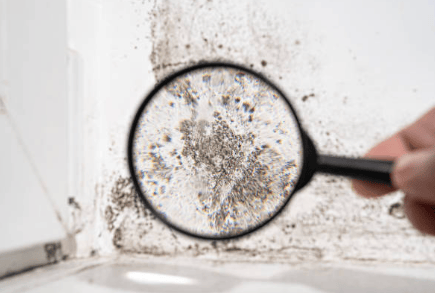In Florida’s warm and humid climate, homeowners often face a common adversary lurking within their walls: mold. To find mold in Florida homes is not just a matter of aesthetics; it’s a significant health and structural integrity concern. We will explore the five ways to effectively find mold in Florida homes with practical tips and strategic advice, underlining the importance of early detection and prevention. Join us as we unravel the secrets to safeguard your home from the potentially damaging effects of mold.
Among the various challenges homeowners in Florida face, mold infestation stands out due to the state’s high humidity levels. However, real estate investors Steve Daria and Joleigh have positioned themselves as invaluable allies in this battle. With extensive experience in the real estate market, especially in buying homes for cash, they offer a raft of solutions that assist homeowners in identifying mold risks and mitigating them effectively.
Understanding Florida’s Mold Environment
Before we delve into the tips and strategies to find mold in Florida homes, it’s better to understand that Florida’s warm and humid climate and seasonal weather patterns like hurricanes and heavy rainfall create a breeding ground for mold spores. Florida was one of the first states to pass laws governing indoor air quality and mold remediation due to its unique environmental conditions. This combination of factors makes mold detection an integral part of home maintenance in the state.
Before you can effectively find mold in Florida homes, it’s crucial to understand what causes and supports mold growth. Mold spores are present everywhere and can infiltrate your home through various means. Once inside, they require moisture, warmth, and an organic nutrient source to thrive. Hence, it’s no surprise that Florida’s homes, abundant with organic building materials like wood and drywall, are particularly susceptible to mold.
The Serious Ramifications of Mold in Homes
Mold threatens the structure of your home and raises serious health concerns. Exposure can cause respiratory problems, nasal congestion, skin irritation, and worsen allergies.
In severe cases, long-term exposure to toxic molds can lead to more significant health issues.
Conducting a Visual Mold Inspection
Visual inspections are your first line of defense against mold infestations. Early detection can prevent significant damage and reduce the chances of developing health issues.
Check Common Mold Spots
To find mold in Florida homes, it’s important to check areas in your home that are more susceptible to moisture, such as bathrooms, kitchens, and basements. Be sure to inspect these areas regularly to prevent any potential issues.
Look for visible signs of mold, including discoloration, fuzziness, and a musty odor. Remember, mold often grows in hidden spots, so thoroughly examine behind and underneath appliances, cabinets, and closets.

Assess Water Damage
High humidity and frequent rainstorms can lead to water intrusion, increasing mold.
Check for any signs of water damage, such as staining, peeling paint, or warping in walls, ceilings, and floors.
It’s essential to address the water source before treating mold, as it will continue to grow in damp conditions.
Understanding Mold Testing
Mold testing can provide definitive evidence of mold in your home. Various tests are available, from DIY home kits to professional air sampling.
Each method has its benefits and drawbacks, so it’s essential to choose the right one based on your circumstances.
DIY Mold Kits
DIY mold test kits are cost-effective and easy to use. They typically involve collecting a sample of air or surface material and sending it to a laboratory for analysis.
While home testing kits can identify the presence of mold, they may not be able to differentiate between types or concentrations of mold, which is critical in discovering the extent of the infestation.
Professional Testing
To find mold in Florida homes, hiring an expert mold inspector is the most accurate mold testing method.
Professionals use specialized equipment to collect samples and provide a comprehensive report detailing the type and quantity of mold present in your home.
This information can be beneficial if you need to make an insurance claim or plan to sell your property.

Utilizing Mold-Detecting Equipment
Technology can be a homeowner’s ally in the fight against mold. Several types of equipment, from moisture meters to thermal imaging cameras, can aid in the detection process.
Moisture Meters
Moisture meters can identify high moisture levels in building materials, which can be an early sign of mold.
By pinpointing areas with excessive dampness, you can intervene before mold has a chance to spread.
Be sure to focus on drywall, wood, and insulation areas where moisture can become trapped.
Thermal Imaging Devices
Thermal imaging devices can detect temperature differentials within your walls, indicating areas of potential mold growth.
These devices can help you ‘see’ through surfaces, catching mold in its early stages when it’s most manageable.
Remember that thermal imagers should be used with other detection methods, as different factors can also cause temperature variations.
Identifying the 5 Most Common Types of Household Mold
No molds are created in the same way; some types are more common in Florida homes due to the climate. Here are the five most prevalent mold species you should be aware of:
Stachybotrys Chartarum (Black Mold)
This infamous mold is known for its toxic effects on health. Look for black, slimy patches that can grow in areas with constant moisture, such as leaking pipes or around air conditioning units.
Penicillium
Penicillium can appear blue or green and is often found on water-damaged materials. It’s one of the most common molds, and it can cause allergic reactions.
Cladosporium
Cladosporium is a variety of mold that can appear black or green. It grows well in warm and cool environments and on fabrics, carpets, and wood surfaces.
Alternaria
This mold is often found in showers and under sinks, requiring a high moisture level to grow. It’s known to cause allergic reactions and asthma symptoms.
Aspergillus
This mold can appear in many colors and is often found in dust, powdery food items, and building materials. It can cause respiratory infections in those with compromised immune systems.
Taking Immediate Action If You Find Mold in Florida Homes
If you find mold in your Florida home, it’s essential to act fast to avoid further damage and protect your health. Here are the steps to take:
Identify and Remedy the Source of Moisture
Mold won’t grow without moisture, so identifying and fixing the source of water leaks or intrusion is your first step.
Isolate the Affected Area
Isolate the area with mold growth to prevent spores from spreading to other parts of your home. Use plastic sheeting and shut off HVAC systems if necessary.
Clean and Remove the Mold
For small areas of mold growth, you can clean it yourself using a mixture of soap and water.
Professionals should handle larger infestations or toxic molds like Stachybotrys chartarum to ensure safe and thorough removal.
Repair and Discard Damaged Materials
After removing the mold, repairing or discarding materials that are too far gone is essential. This may involve replacing drywall, carpeting, or insulation.
Prevent Future Mold Growth
Prevent mold from returning by improving ventilation, using dehumidifiers, and maintaining regular cleaning.
Engaging in Regular Mold Inspections
When dealing with mold, it’s always better to prevent it from occurring rather than trying to get rid of it once it’s developed.
Regular inspections can prevent mold growth by identifying and fixing underlying issues.
Schedule Professional Inspections Annually
Consider scheduling a professional mold inspection at least once a year, especially if you’ve had mold problems or live in an area known for humidity issues.
An expert can detect signs of potential mold growth that you may have overlooked.
Perform Routine DIY Checks
In between professional inspections, make it a habit to conduct your visual checks for mold.
Stay vigilant for signs of water damage and musty odors, and don’t hesitate to investigate further if you have a clue that something might be amiss.
Conclusion
Mold can pose a significant threat to the structural integrity of your home, as well as the health of your family. It is crucial to promptly address mold problems to avoid further damage caused by their spreading. In Florida, where the climate is conducive to mold growth, awareness, and early detection are crucial in preventing a minor inconvenience from becoming a significant problem.
Remember, to find mold in Florida homes is just the first step. If you discover mold, it’s essential to determine the infestation’s type, source, and extent to develop an effective remediation plan. Whether through DIY methods or professional assistance, the ultimate goal is to secure a mold-free environment you can enjoy for years.
Armed with the knowledge and tools outlined above, you can approach the task of finding mold in Florida homes with the confidence and thoroughness it deserves. Don’t wait until it’s too late—start safeguarding your home against mold today to ensure a healthy and happy living environment.

